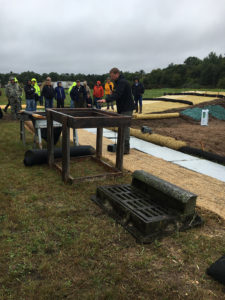What Is Erosion and Sediment Control
Erosion is defined as the process of eroding or being eroded by wind, water, or other natural agents. When bare soil is exposed and not stabilized, the speed in which erosion occurs increases. This causes sediment to mobilize and can potentially harm adjacent waterways. While stabilization of an area cannot always be achieved in a timely manner, certain measures can be implemented to control the rate of erosion. These measures are not always 100% effective so additional sediment control devices are critical. The sediment control devices focus on stopping sediment from leaving the site rather than preventing erosion. In combination, erosion and sediment control can go a long way in reducing the stress on our nearby water bodies.
Why Is Erosion and Sediment Control Important
Once sediment enters a waterway, it can immediately start to affect the wildlife and ecosystem. Sediment can clog the gills of fish, it can alter habitats, and create poor living conditions for many aquatic organisms. It can also hinder the water quality, which many of us choose to recreate in.
How To Reduce Sediment Loss On Construction Sites
There are a variety of sources that contribute to sediment loadings into waterways but a construction site is one source that can be contained with the proper measures. Construction sites are constantly evolving throughout a project’s road to completion. The need for various erosion control measures can also evolve throughout this timeframe. Below are a few common best management practices that can be used to keep your site from degrading and losing sediment.
Trackout Control Practices
Trackout control practices are vital to keep neighboring roads clear of sediment and mud. When a site lacks a proper trackout control practice, sediment can be tracked out where it can then be washed into adjacent ditches and storm sewers. Typically, a stone tracking pad that is at least 50 feet in length and 12 feet wide will be installed near the exit of the site.
The Wisconsin Department of Natural Resources (WDNR) recently released their Technical Standard 1057 in July of this year. This updated standard calls for a 3-inch clear stone gradation for a stone tracking pad but also now allows for a manufactured trackout device at a minimum of 32 feet in length. The benefit to a manufactured trackout device is the ability to re-use it on future sites. It also eliminates the need for maintenance of a stone tracking pad, although washing of this device to assure its effectiveness will still need to be monitored.
Ditch Checks
Ditch checks are critical to avoid further erosion of channel banks as well as to filter out any sediment that may already be on its way off of the site. While the type of ditch check varies depending on the design of the site, the main purpose of this measure is to deconcentrate the flow by slowing it down and spreading it out. Sand bag and rock bag ditch checks tend to be better at damming the flow to slow it down while fiber logs and straw wattles slow flow down by allowing water to pass through the media. Some sediment may settle out of the flow above the ditch check, and some will be trapped in the fiber logs and straw wattles as the water passes through them.

Ditch Check
Inlet Protection
The last line of defense at any construction site are inlet protections. If all other measures fail on site, inlet protections collect sediment before it enters a nearby inlet or ditch. It is important to note the different types of inlet protections. While installing a piece of geotextile fabric under an inlet grate may be sufficient for certain situations, it may not always have sufficient capacity to collect sediment loadings over the life of the project. If that is the case, inlet insert bags or a framed structure wrapped with geotextile fabric should be used.

Inlet Protection
With properly installed erosion control practices and the continuous monitoring of a construction site, sediment loss can be significantly reduced, allowing for improved waterways moving forward.
Contact our municipal engineering and water resource experts to learn more today!
